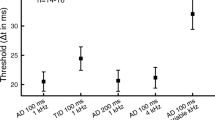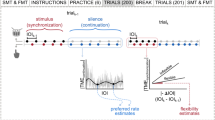Abstract
The present study investigated the learning of a culturally unfamiliar musical rhythm, leading to the development of temporal expectations, and it explored the potential for generalization across tempi and tasks. With that aim, we adapted the serial reaction time task to examine the learning of temporal structures by an indirect method. The temporal pattern employed was based on a complex interval ratio (2:3) and compared to one based on a simple interval ratio (1:2). In the exposure phase, non-musician participants performed a two-choice speeded discrimination task that required responding by key press to each event of the simple or complex auditory pattern. Participants were not informed about the temporal regularities; their task solely concerned the discrimination task. During exposure (Experiments 1–3), response times decreased over time for both temporal patterns, but particularly for the events following the longer interval of the more complex 2:3 pattern. Exposure further influenced performance in subsequent testing phases, notably the precision of tap timing in a production task (Experiment 2) and temporal expectations in a perception task (Experiment 3). Our findings promote the new paradigm introduced here as a method to investigate the learning of temporal structures.





Similar content being viewed by others
Notes
These syllables might differ slightly in their perceptual center, which can be influenced by the initial consonant. However, the influence of these differences should be rather minimal because the syllables had a duration of 470 ms, the minimal SOA was 700 ms and the syllables were presented in random order in the exposure blocks.
The observation that syllable identification was not at ceiling was certainly due to the speeded response requirement, the sequential chaining and the continuous responding. The syllables were clearly distinguishable, as evidenced by a short perceptual test: the syllables were presented (out of context with 5 repetitions for each syllable, presented in random order) to 14 participants; identification scores were 100% for each syllable and participant.
The 224-Exposure served as a control group for the 223-Exposure in two respects: (1) it controlled for exposure to the syllable sequences with a short–short–long grouping, which reinforced binary interval structure with the 224-pattern, and (2) it allowed us to estimate whether the switch in tasks (from the exposure RT task to the production task in Experiment 2 and to the detection task in Experiment 3) might incur a general switch cost (e.g., Schneider & Logan, 2006).
A pooled analysis on the exposure phase of Experiments 1–3 (with Experiment as a between-participants factor) confirmed the interaction between Group, Block and Position (p = 0.001), which did not interact with Experiment (p = 0.69).
References
Aschersleben, G. (2002). Temporal control of movements in sensorimotor synchronization. Brain and Cognition, 48, 66–79.
Berry, D. C. (2002). How implicit is implicit learning? In G. Underwood (Ed.), Implicit Cognition (2nd ed., pp. 203–226). Oxford: OUP.
Brandon, M., Tillmann, B., Stevens, C., & Terry, J. (in preparation). Implicit learning of temporal structures with weak and strong meter.
Bremner, A., Mareschal, D., Destrebecqz, A., & Cleeremans, A. (2007). Cognitive control of sequential knowledge at 2 years of age: Evidence from an incidental sequence learning and generation task. Psychological Science, 18(3), 261–266.
Buchner, A., & Steffens, M. C. (2001). Simultaneous learning of different regularities in sequence learning tasks: limits and characteristics. Psychological Research, 65, 71–80.
Buchner, A., Steffens, M. C., Erdfelder, E., & Rothkegel, R. (1997). A multinomial model to assess fluency and recollection in a sequence learning task. Quarterly Journal of Experimental Psychology, 50, 631–663.
Cleeremans, A., & McClelland, J. L. (1991). Learning the structure of event sequences. Journal of Experimental Psychology: General, 120, 235–253.
Cohen, J., MacWhinney, B., Flatt, M., & Provost, J. (1993). PsyScope: An interactive graphic system for designing and controlling experiments in the psychology laboratory using Macintosh computers. Behavior Research Methods, Instruments and Computers, 25, 257–271.
Collier, G. L., & Wright, C. E. (1995). Temporal rescaling of simple and complex ratios in rhythmic tapping. Journal of Experimental Psychology: Human Perception and Performance, 21, 602–627.
Deroost, N., & Soetens, E. (2006). Perceptual or motor learning in SRT tasks with complex sequence structures. Psychological Research, 70, 88–102.
Desain, P., & Honing, H. (2003). The formation of rhythmic categories and metric priming. Perception, 32, 341–365.
Destrebecqz, A., & Cleeremans, A. (2001). Can sequence learning be implicit? New evidence with the process dissociation procedure. Psychonomic Bulletin and Review, 8(2), 343–350.
Eisler, H., Eisler, A. D., & Hellström, Å. (2008). Psychophysical issues in the study of time perception. In S. Grondin (Ed.), Psychology of time (pp. 75–109). Bingley, UK: Emerald.
Fitch, W. T., & Rosenfeld, A. J. (2007). Perception and production of syncopated rhythms. Music Perception, 25, 43–58.
Fletcher, P. C., Zafiris, O., Frith, C. D., et al. (2005). On the benefits of not trying: Brain activity and connectivity reflecting the interactions of explicit and implicit sequence learning. Cerebral Cortex, 15, 1002–1015.
Fraisse, P. (1956). Les structures rhythmiques. Louvain: Publication Universitaires de Louvain.
Fraisse, P. (1966). L’anticipation de stimulus rythmiques: Vitesse d’établissement et précision de la synchronisation. [Anticipation of rhythmic stimuli: Speed of establishment and precision of synchronization.] L’Année Psychologique, 66, 15–36.
Fraisse, P. (1982). Rhythm and tempo. In D. Deutsch (Ed.), The psychology of music (pp. 149–180). NY: Academic Press.
Handel, S. (1992). The differentiation of rhythmic structure. Perception and Psychophysics, 52, 497–507.
Hannon, E. E., & Trehub, S. E. (2005a). Tuning into musical rhythms: Infants learn more readily than adults. Proceedings of the National Academy of Sciences (USA), 102, 12639–12643.
Hannon, E. E., & Trehub, S. E. (2005b). Metrical categories in infancy and adulthood. Psychological Science, 16, 48–55.
Hébert, S., & Cuddy, L. L. (2002). Detection of metric structure in auditory figural patterns. Perception and Psychophysics, 64, 909–918.
Jones, M. R., & Boltz, M. (1989). Dynamic attending and responses to time. Psychological Review, 96, 459–491.
Jones, M. R., Johnston, H., & Puente, J. (2006). Effects of auditory pattern structure on anticipatory and reactive attending. Cognitive Psychology, 53, 59–96.
Kauffman, R. (1980). African rhythm: a reassessment. Ethnomusicology, 24, 393–415.
Keller, P. E., & Repp, B. H. (2004). When two limbs are weaker than one: Sensorimotor syncopation with alternating hands. The Quarterly Journal of Experimental Psychology. Section A: Human Experimental Psychology, 57A, 1085–1101.
Keller, P. E., & Repp, B. H. (2005). Staying offbeat: Sensorimotor syncopation with structured and unstructured auditory sequences. Psychological Research, 69, 292–309.
Large, E. W. (2008). Resonating to musical rhythm: Theory and experiment. In Simon Grondin, (Ed.) The psychology of time. Emerald.
Large, E. W., & Jones, M. R. (1999). The dynamics of attending: How people track time-varying events. Psychological Review, 106(1), 119–159.
Large, E. W. & Velasco, M. G. (2009). Modeling of pulse and meter as neural oscillation. Presentation at the Conference of the Society for Music Perception and Cognition, 3–6 August 2009 Indiana University–Purdue University, Indianapolis Indianapolis, Indiana, USA.
London, J. (1995). Some examples of complex meters and their implications for models of metric perception. Music Perception, 13, 59–77.
Niemi, P., & Näätänen, R. (1981). Foreperiod and simple reaction time. Psychological Bulletin, 89, 133–162.
Nissen, M. J., & Bullemer, P. (1987). Attentional requirements of learning: evidence from performance measures. Cognitive Psychology, 19, 1–32.
Patel, A. D., & Daniele, J. R. (2003). An empirical comparison of rhythm in language and music. Cognition, 87, B35–B45.
Patel, A. D., Iversen, J. R., Chen, Y., & Repp, B. H. (2005). The influence of metricality and modality on synchronization with a beat. Experimental Brain Research, 163, 226–238.
Penel, A., & Jones, M. R. (2005). Speeded detection of a tone embedded in a quasi-isochronous sequence: Effects of a task-irrelevant temporal irregularity. Music Perception, 22, 371–388.
Perruchet, P. (2008). Implicit learning. In H.L. Roediger, III (Ed.), Cognitive psychology of memory. Vol. 2 of Learning and memory: A comprehensive reference, 4 vols. (J. Byrne, Editor). Oxford: Elsevier (p. 597–621).
Perruchet, P., Bigand, E., & Benoit-Gonin, F. (1997). The emergence of explicit knowledge during the early phase of learning in serial reaction time tasks. Psychological Research, 60, 4–13.
Peters, M. (1989). The relationship between variability of intertap intervals and interval duration. Psychological Research, 51, 38–42.
Povel, D.-J. (1981). Internal representation of simple temporal patterns. Journal of Experimental Psychology: Human Perception and Performance, 7, 3–18.
Povel, D.-J., & Essens, P. (1985). Perception of temporal patterns. Music Perception, 2, 411–440.
Pressing, J. (1983). Cognitive isomorphisms between pitch and rhythm in world musics: West Africa, the Balkans and Western tonality. Studies in Music, 17, 38–61.
Reed, J., & Johnson, P. (1994). Assessing implicit learning with indirect tests: Determining what is learned about sequence structure. Journal of Experimental Psychology: Learning, Memory, and Cognition, 20, 585–594.
Remillard, G. (2003). Pure perceptual-based sequence learning. Journal of Experimental Psychology: Learning, Memory, and Cognition, 29, 581–597.
Repp, B. H. (1997). Variability of timing in expressive piano performance increases with interval duration. Psychonomic Bulletin and Review, 4, 530–534.
Repp, B. H., London, J., & Keller, P. E. (2005). Production and synchronization of uneven rhythms at fast tempi. Music Perception, 23, 61–78.
Salidis, J. (2001). Nonconscious temporal cognition: Learning rhythms implicitly. Memory and Cognition, 29, 1111–1119.
Schmuckler, M. A., & Boltz, M. G. (1994). Harmonic and rhythmic influences on musical expectancy. Perception and Psychophysics, 56, 313–325.
Schneider, D. W., & Logan, G. D. (2006). Hierarchical control of cognitive processes: Switching tasks in sequences. Journal of Experimental Psychology: General, 135, 623–640.
Schupp, W., & Schlier, C. (1972). The dependence of simple reaction time on temporal patterns of stimuli. Kybernetik, 11, 105–111.
Semjen, A., & Ivry, R. B. (2001). The coupled oscillator model of between-hand coordination in alternate-hand tapping: A reappraisal. Journal of Experimental Psychology: Human Perception and Performance, 27, 251–265.
Shanks, D. R., & St. John, M. F. (1994). Characteristics of dissociable human learning systems. Behavioral and Brain Sciences, 17, 367–447.
Shin, J. C., & Ivry, R. B. (2002). Concurrent learning of temporal and spatial sequences. Journal of Experimental Psychology Learning Memory and Cognition, 28, 445–457.
Snyder, J. S., Hannon, E. E., Large, E. W., & Christiansen, M. H. (2006). Synchronization and continuation tapping to complex meters. Music Perception, 24, 135–146.
Sternberg, S., Knoll, R. L., & Zukofsky, P. (1982). Timing by skilled musicians. In D. Deutsch (Ed.), The psychology of music (pp. 181–239). Orlando, FL: Academic.
Summers, J. J., Bell, R., & Burns, B. D. (1989). Perceptual and motor factors in the imitation of simple temporal patterns. Psychological Research, 50, 23–27.
Summers, J. J., Hawkins, S. R., & Mayers, H. (1986). Imitation and production of interval ratios. Perception and Psychophysics, 39, 437–444.
Thiessen, E. D., & Saffran, J. R. (2003). When cues collide: use of stress and statistical cues to word boundaries by 7- to 9-month-old infants. Developmental Psychology, 39, 706–716.
Tillmann, B., Bharucha, J. J., & Bigand, E. (2000). Implicit learning of tonality: a self-organizing approach. Psychological Review, 107, 885–913.
Tillmann, B., & Lebrun-Guillaud, G. (2006). Influence of tonal and temporal expectations on chord processing and on completion judgments of chord sequences. Psychological Research, 70, 345–358.
Acknowledgments
This research was supported by the Eminent Visiting Researcher scheme of the University of Western Sydney and the Australian Research Council Discovery Project (DP0986394) scheme. We thank Catherine Best for discussions on the present project as well as Clare Howell, Julien Tardieu, and Tim Byron for assistance with data collection and analyses.
Author information
Authors and Affiliations
Corresponding author
Rights and permissions
About this article
Cite this article
Tillmann, B., Stevens, C. & Keller, P.E. Learning of timing patterns and the development of temporal expectations. Psychological Research 75, 243–258 (2011). https://doi.org/10.1007/s00426-010-0302-7
Received:
Accepted:
Published:
Issue Date:
DOI: https://doi.org/10.1007/s00426-010-0302-7




